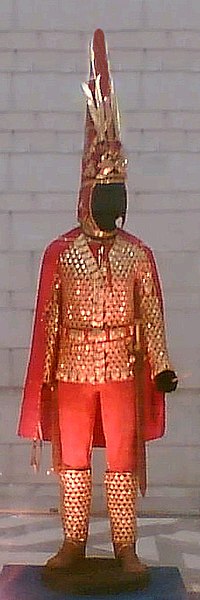Kazakhstan, the largest country fully within the Eurasian Steppe, has been a historical crossroads and home to numerous different peoples, states and empires throughout history. Throughout history, peoples on the territory of modern Kazakhstan had nomadic lifestyle, which developed and influenced Kazakh culture.
Cataphract-style parade armor of a royal Saka from the Issyk kurgan.
Kirghiz envoys give a white horse to the Qianlong Emperor of China (1757), soon after the Qing expelled the Mongols from Xinjiang. Soon trade began in Yining and Tacheng of Kazakh horses, sheep and goats for Chinese silk and cotton fabrics.
General Secretary of the Communist Party of Kazakhstan Dinmukhamed Konayev (1964–1986)
Nazarbayev (second from left) at the signing of the Alma-Ata Protocol, December 1991.
The Kazakh Khanate, in eastern sources known as Ulus of the Kazakhs, Ulus of Jochi, Yurt of Urus, was a Kazakh state in Central Asia, successor of the Golden Horde existing from the 15th to the 19th century, centered on the eastern parts of the Desht-i Qipchaq.
A 2015 Kazakhstani stamp commemorating the 550th Anniversary of the Kazakh Khanate's establishment
Kazakh leader and his wife. Huang Qing Zhigong Tu, 1769
Kazakh commoner with his wife. Huang Qing Zhigong Tu, 1769
Kazakh delegates (flag "哈萨克") in Peking from the 1761 painting Ten Thousand Nations Coming to Pay Tribute








